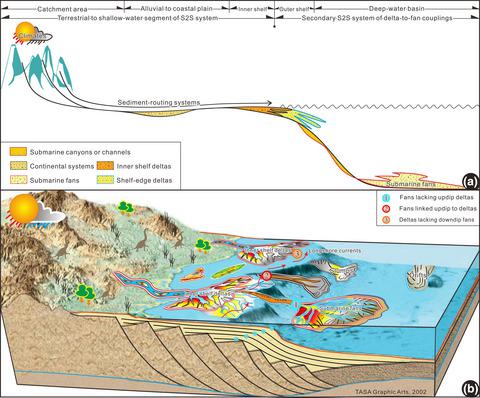当前位置:
X-MOL 学术
›
Basin Res.
›
论文详情
Our official English website, www.x-mol.net, welcomes your
feedback! (Note: you will need to create a separate account there.)
Delta-to-fan source-to-sink coupling as a fundamental control on the delivery of coarse clastics to deepwater: Insights from stratigraphic forward modelling
Basin Research ( IF 2.8 ) Pub Date : 2021-08-13 , DOI: 10.1111/bre.12591 Chenglin Gong 1, 2 , Dongwei Li 2 , Ronald J. Steel 3 , Yang Peng 2 , Shaohua Xu 4 , Yingmin Wang 2
Basin Research ( IF 2.8 ) Pub Date : 2021-08-13 , DOI: 10.1111/bre.12591 Chenglin Gong 1, 2 , Dongwei Li 2 , Ronald J. Steel 3 , Yang Peng 2 , Shaohua Xu 4 , Yingmin Wang 2
Affiliation

|
We propose that a more readily studied, secondary source-to-sink (S2S) systems can be formed on direct-fed margins, in which shelf-edge deltas are ‘sources’ and deep-water fans are terminal depositional ‘sinks’, with channels working as delivery ‘conduits’ in between. DionisosFlow stratigraphic-forward model, coupled to seismic and borehole data from middle Miocene Pearl River margin, are used to explore physical and conceptual linkages of delta-to-fan S2S systems, with a focus on the predictability of when and how coarse clastics are delivered from the deltas down to the submarine fans. Middle Miocene Pearl River delta-to-fan S2S coupling was stratigraphically enacted in three main ways: (a) deltas that lack downdip fans: high sea level or low sediment supply caused coarse clastics to be stored mainly on inner to outer shelf areas; (b) deltas that are linked downdip to fans: coarse clastics were funneled to submarine fans through slope channels, via direct delta-to-fan S2S linkages created by delta overreach at shelf break or channels extending back to shelf-margin prodeltas; (c) fans that lack updip, coeval deltas: coarse shelf clastics were carried laterally by longshore or other shelf currents, but eventually captured by canyon heads, and then delivered directly to the basin floor. Moreover, our DionisosFlow stratigraphic-forward models suggest that an oscillation in sea-level behaviour from slowly falling to rapidly falling would result in a within-system tract surface occurring within the falling-stage systems tract. This surface is identified as a significant lower-order unconformity in its proximal reaches and as a correlative conformity distally. Within-system tract surfaces are identified by a change in shelf-edge trajectory regimes from flat to slight falling to moderately falling and in architecture from mixed progradation and degradation to dominant degradation. They are coeval with the onset of the deposition of submarine fans linked updip to deltas or lacking updip deltas, highlighting that sandy deposits can be compartmentalized even within a single systems tract.
中文翻译:

Delta-to-fan 源-汇耦合作为粗碎屑向深水输送的基本控制:来自地层正向建模的见解
我们建议可以在直接补给边缘形成一个更容易研究的二次源到汇 (S2S) 系统,其中陆架边缘三角洲是“源”,深水扇是终端沉积“汇”,其中渠道作为两者之间的交付“管道”。DionisosFlow 地层向前模型,结合来自中中新世珠江边缘的地震和钻孔数据,用于探索三角洲到扇 S2S 系统的物理和概念联系,重点是粗碎屑输送的时间和方式的可预测性从三角洲到海底扇。中中新世珠江三角洲-扇 S2S 耦合在地层上主要以三种方式形成: (a) 缺乏下倾扇的三角洲:高海平面或低沉积物供应导致粗碎屑主要储存在陆架内至外陆区;(b) 与扇形下倾相连的三角洲:粗碎屑通过斜坡通道汇入海底扇,通过三角洲在陆架断裂处超伸或延伸回陆架边缘前三角洲的通道产生的直接三角洲与扇形 S2S 联系;(c) 缺乏上倾角的扇扇,同时期三角洲:粗糙的陆架碎屑被沿岸或其他陆架洋流横向携带,但最终被峡谷头捕获,然后直接输送到盆地底部。此外,我们的 DionisosFlow 地层向前模型表明,海平面行为从缓慢下降到快速下降的振荡将导致下降阶段系统域内出现系统内域表面。该表面在其近端被确定为一个显着的低级不整合面,而在远端则被识别为相关的整合面。系统内区域表面通过陆架边缘轨迹状态从平坦到轻微下降到中度下降以及建筑从混合前移和退化到显着退化的变化来识别。它们与与上倾三角洲相连或缺乏上倾三角洲的海底扇沉积的开始同时发生,这表明沙质沉积物即使在单个系统域内也可以分隔。
更新日期:2021-08-13
中文翻译:

Delta-to-fan 源-汇耦合作为粗碎屑向深水输送的基本控制:来自地层正向建模的见解
我们建议可以在直接补给边缘形成一个更容易研究的二次源到汇 (S2S) 系统,其中陆架边缘三角洲是“源”,深水扇是终端沉积“汇”,其中渠道作为两者之间的交付“管道”。DionisosFlow 地层向前模型,结合来自中中新世珠江边缘的地震和钻孔数据,用于探索三角洲到扇 S2S 系统的物理和概念联系,重点是粗碎屑输送的时间和方式的可预测性从三角洲到海底扇。中中新世珠江三角洲-扇 S2S 耦合在地层上主要以三种方式形成: (a) 缺乏下倾扇的三角洲:高海平面或低沉积物供应导致粗碎屑主要储存在陆架内至外陆区;(b) 与扇形下倾相连的三角洲:粗碎屑通过斜坡通道汇入海底扇,通过三角洲在陆架断裂处超伸或延伸回陆架边缘前三角洲的通道产生的直接三角洲与扇形 S2S 联系;(c) 缺乏上倾角的扇扇,同时期三角洲:粗糙的陆架碎屑被沿岸或其他陆架洋流横向携带,但最终被峡谷头捕获,然后直接输送到盆地底部。此外,我们的 DionisosFlow 地层向前模型表明,海平面行为从缓慢下降到快速下降的振荡将导致下降阶段系统域内出现系统内域表面。该表面在其近端被确定为一个显着的低级不整合面,而在远端则被识别为相关的整合面。系统内区域表面通过陆架边缘轨迹状态从平坦到轻微下降到中度下降以及建筑从混合前移和退化到显着退化的变化来识别。它们与与上倾三角洲相连或缺乏上倾三角洲的海底扇沉积的开始同时发生,这表明沙质沉积物即使在单个系统域内也可以分隔。











































 京公网安备 11010802027423号
京公网安备 11010802027423号